Wikipedia:Picture of the day/June 2019
|
Featured picture tools: |
These featured pictures, as scheduled below, appeared as the picture of the day (POTD) on the English Wikipedia's Main Page in June 2019. Individual sections for each day on this page can be linked to with the day number as the anchor name (e.g. [[Wikipedia:Picture of the day/June 2019#1]] for June 1).
You can add an automatically updating POTD template to your user page using {{Pic of the day}} (version with blurb) or {{POTD}} (version without blurb). For instructions on how to make custom POTD layouts, see Wikipedia:Picture of the day.Purge server cache
June 1

|
The green hairstreak (Callophrys rubi) is a small butterfly in the family Lycaenidae. It has a wingspan reaching about 26–30 millimetres (1.0–1.2 in) in length. The overside of the wings is a uniform dull brown, with two paler patches on the male's forewings made up of scent scales. The underside is bright green, with a thin white line that is often reduced to a faint row of dots or even missing altogether. The iridescent green colour of the underside is a structural colour caused by the diffraction and interference of light by microscopic repeating structures forming a diffraction grating in the wing scales. Green hairstreaks can be found at the end of March, with their flight time usually lasting until the end of June, but they are sometimes seen in July and early August. They never rest with their wings open, to maintain their green camouflage. The males exhibit territorial behaviour. This picture, taken in 2015, shows a green hairstreak near Aston Upthorpe, Oxfordshire, within the North Wessex Downs Area of Outstanding Natural Beauty in the United Kingdom. Photograph credit: Charles J. Sharp
Recently featured:
|
June 2
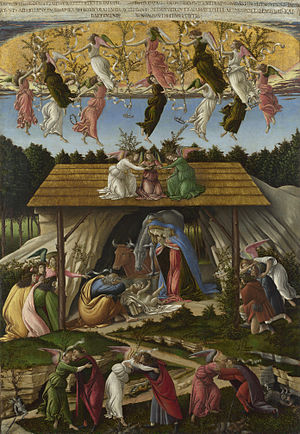
|
The Mystical Nativity is an oil-on-canvas painting by the Italian Renaissance master Sandro Botticelli, dated around 1500 to 1501. It is his only signed work and has unusual iconography for a painting of the Nativity. The Virgin Mary is shown kneeling before the Christ Child in the centre, in the presence of the shepherds and wise men who are visiting him. At the bottom of the work, three angels embrace three men, seeming to raise them up from the ground, while seven devils behind them flee to the underworld. In Renaissance times, paintings of the Last Judgement showed viewers the reckoning of the damned and the saved at the time of Christ's Second Coming. According to art historian Jonathan Nelson, "in echoing this kind of painting the Mystical Nativity is asking us to think not only of Christ's birth but of his return". The Greek inscription at the top of the work, referencing the Book of Revelation, translates as: 'This picture, at the end of the year 1500, in the troubles of Italy, I, Alessandro, in the half-time after the time, painted, according to the eleventh [chapter] of Saint John, in the second woe of the Apocalypse, during the release of the devil for three and a half years; then he shall be bound in the twelfth [chapter] and we shall see [him buried] as in this picture'. It has been suggested that the work may be connected with the influence of the fanatical preacher Girolamo Savonarola, who was active in Florence at the time and whose influence appears in a number of late paintings by Botticelli. The painting is in the collection of the National Gallery in London. Painting credit: Sandro Botticelli
Recently featured:
|
June 3

|
Allen Ginsberg (June 3, 1926 – April 5, 1997) was an American poet, philosopher and writer. He is considered to be one of the leading figures of both the Beat Generation during the 1950s and the counterculture that soon followed. Ginsberg vigorously opposed militarism, economic materialism and sexual repression; he was also known to embody various aspects of this counterculture, such as his views on drugs, hostility to bureaucracy and openness to Eastern religions. He was one of many influential American writers of his time who were associated with the Beat Generation, including Jack Kerouac and William S. Burroughs. Ginsberg is best known for his poem "Howl", in which he denounced what he saw as the destructive forces of capitalism and conformity in the United States. This picture, taken in 1979, shows Ginsberg signing books at the Athenaeum bookstore in Amsterdam. The photograph is in the collection of the Algemeen Nederlandsch Fotobureau (General Dutch Photo Bureau, also known as Anefo), part of the Dutch national archives. Photograph credit: Hans van Dijk; cropped by Materialscientist
Recently featured:
|
June 4
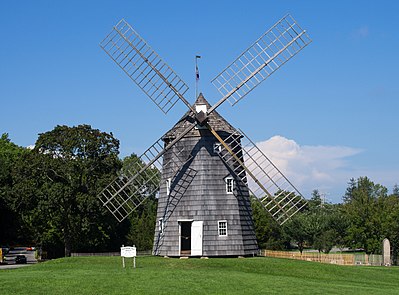
|
Hook Windmill, also known as Old Hook Mill, pictured here in 2016, is a historic windmill on North Main Street in East Hampton, New York. It was built in 1806 and operated regularly until 1908. One of the most complete of the extant windmills on Long Island, it was sold to the town of East Hampton in 1922. The building was listed on the National Register of Historic Places in 1978 and is part of the North Main Street Historic District. It is open daily to visitors. Photograph credit: Rhododendrites
Recently featured:
|
June 5

|
The Mercedes-Benz W115 is a series of executive sedans introduced in 1968 by Mercedes-Benz, along with the similar W114, to replace the earlier W110 series. They were manufactured until model year 1976, when the W123 was released. W115 models featured four-cylinder engines and were marketed with the model numbers 200, 220, 230 and 240, some of which may have a "D" appended to indicate the use of a diesel engine instead of a petrol engine. The series was designed by Paul Bracq, featuring a three-box design. At the time, Mercedes retailed sedans in two size classes, with the W114 and the W115 positioned below the Mercedes-Benz S-Class. This picture shows a 1973 Mercedes-Benz W115 220D, photographed in 2015 near Gorczenica, Poland. Photograph credit: 1bumer
Recently featured:
|
June 6

|
The Portrait of Marchesa Brigida Spinola-Doria is an oil-on-canvas painting by Flemish artist Sir Peter Paul Rubens, dating to 1606. It was commissioned by Marchese Giacomo Massimiliano Doria of Genoa and depicts his wife, Marchesa Brigida, shortly after their wedding in 1605. Both the Marchese and the Marchesa were members of prominent families: the Doria and the Spinola, respectively. In the painting, the Marchesa is shown in an opulent setting to convey luxury; adorned with jewels, she wears a satin and lace dress, with a broad ruff around her neck. Lighting is used to emphasise the drapery of her bulky wedding gown, while she looks down on the viewer, establishing the necessity to hang the finished portrait above the height of viewers. It has been trimmed several times on each side, removing the garden shown in the background and the lower part of the figure, including the bottom of the Marchesa's floor-length gown. The painting, part of the Samuel H. Kress Collection, now hangs in the National Gallery of Art in Washington, D.C. Painting credit: Peter Paul Rubens
Recently featured:
|
June 7

|
The European paper wasp (Polistes dominula or Polistes dominulus) is one of the most common species of wasps in the genus Polistes. Originally described in 1791 by German naturalist Johann Ludwig Christ as Vespa dominula, it is native to southern Europe and North Africa, as well as temperate parts of Asia as far east as China. It has also been introduced to Australia, New Zealand, South Africa and the Americas. The species is common and cosmopolitan due to its exceptional survival features, such as a productive colony cycle, a short development time and a higher ability to endure predator attacks. It generally lives in temperate, terrestrial habitats, such as chaparral, forest and grassland biomes. This picture shows a young European paper wasp queen guarding her nest and eggs. Photograph credit: Joaquim Alves Gaspar
Recently featured:
|
June 8

|
The Coldstream Guards is the oldest regiment of the British Army in continuous active service, part of the Foot Guards of the Guards Division. It originated in Coldstream, Scotland, where General George Monck founded the regiment in 1650. The Coldstream Guards is one of two regiments of the Household Division that can trace its lineage to the New Model Army, the other being the Blues and Royals (Royal Horse Guards and 1st Dragoons). During the Crimean War (1853–1856), the Coldstream Guards fought in the Battle of the Alma, the Battle of Inkerman and the Siege of Sevastopol. On its return, four men of the regiment were awarded the newly instituted Victoria Cross. This picture is a carbon print of a photograph titled Heroes of the Crimean War. From left to right, the guardsmen depicted are Joseph Numa, John Potter and James Deal. The photograph is dated 1856 and was produced by Hughes & Mullins, after a similar photograph by Cundall & Howlett. This copy was commissioned by Queen Victoria and printed around 1889 to 1891; it is now part of the Royal Collection. Photograph credit: Hughes & Mullins, after Cundall & Howlett; restored by Adam Cuerden
Recently featured:
|
June 9

|
Indriati Iskak (born 9 June 1942) is an Indonesian actress turned psychologist and marketer. Born in Surabaya, she made her feature film debut in 1957, starring in Usmar Ismail's commercially successful Tiga Dara ('Three Maidens'), alongside Chitra Dewi and Mieke Wijaya. Indriati formed a girl group named the Baby Dolls and starred in eight more films before retiring from cinema in 1963. In 1968, she graduated with a degree in psychology from the University of Indonesia. After some time working at the Indonesian Air Force's psychological counselling bureau, Indriati began working at Unilever in the 1970s, staying with the company for twenty-six years; she also taught psychology at the Jakarta Art Institute. Since 1994, she has worked for consulting firm Makki Makki as a marketing and branding consultant. This picture is a promotional still featuring Indriati, dated around 1960, published by the Tati Photo Studio in Jakarta. Photograph credit: Tati Photo Studio; restored by Chris Woodrich and Adam Cuerden
Recently featured:
|
June 10

|
The Alba Madonna is an oil painting by the Italian High Renaissance artist Raphael, produced around 1510. A circular piece, it depicts the Virgin Mary, the Christ Child and a young John the Baptist in a typical Italian countryside. John is holding up a cross to Jesus, which the latter is grasping. All three figures are staring at the cross. They are grouped to the left of the round design, but Mary's outstretched arm and billowing cloak balance the image. Originally painted on a circular wooden panel, the painting was transferred to a square canvas in the early nineteenth century, while in the collection of the Hermitage Museum in Saint Petersburg. Through analysis of the painting, it has been determined that the original panel was severely splitting down the center and on the right side. The landscape on the far right of the work was damaged during the transfer process. The painting is now in the permanent collection of the National Gallery of Art in Washington, D.C. Painting credit: Raphael
Recently featured:
|
June 11

|
Millicent Fawcett (11 June 1847 – 5 August 1929) was a British intellectual, political leader, activist and writer, known primarily for her work as a campaigner for women's suffrage. She took a moderate line regarding women's rights but was a tireless campaigner. In 1897 she became the president of the National Union of Women's Suffrage Societies, a position she held until 1919. She placed much of her focus on improving women's opportunities for higher education and served as a governor of Bedford College, London (now part of Royal Holloway), as well as co-founding Newnham College, Cambridge. As a politician, Fawcett was appointed to lead the British government's commission to South Africa in July 1901, investigating conditions in the concentration camps that had been created there in the wake of the Second Boer War. Her report corroborated what campaigner Emily Hobhouse had said about the terrible conditions in the camps. This picture of Fawcett was produced by Elliott & Fry, a Victorian photography studio based in London. The photograph was published in 1913; this copy is in the collection of the Library of Congress in Washington, D.C. Photograph credit: Elliott & Fry; restored by Adam Cuerden
Recently featured:
|
June 12
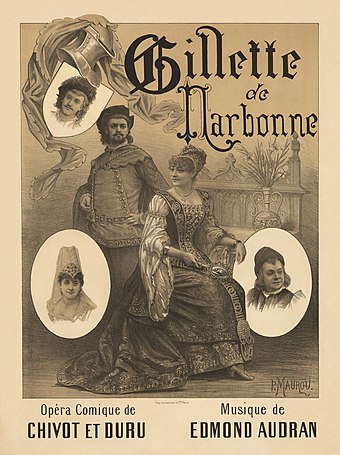
|
Gillette de Narbonne is a French opéra comique in three acts, with music by Edmond Audran and libretto by Alfred Duru and Henri Chivot. It is based on a fabliau from The Decameron, the same tale on which Shakespeare based his play All's Well That Ends Well, depicting a rejected bride posing as another woman to deceive her husband into consummating their marriage. The authors wrote for a cast largely familiar from their earlier work, including mezzo-soprano Marie Montbazon, tenor Charles Lamy and baritone Louis Morlet. The first performance of the opera took place on 11 November 1882, at the Théâtre des Bouffes-Parisiens in Paris, where it ran for 122 performances, until the following March. Productions followed in London, where the piece failed to run, as well as in Berlin, where it was more successful. This picture is a poster from the original production of Gillette de Narbonne, produced by French printmaker Paul Maurou in 1883. This copy is in the collection of the Bibliothèque nationale de France. Poster credit: Paul Maurou; restored by Adam Cuerden
Recently featured:
|
June 13
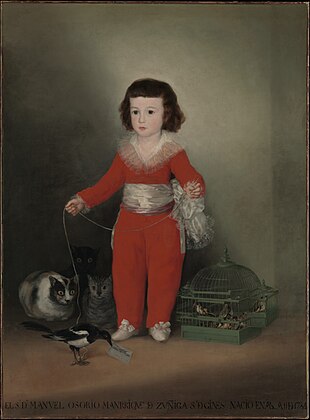
|
Manuel Osorio Manrique de Zúñiga, also known as the "Red Boy", is an oil-on-canvas portrait by Spanish artist Francisco Goya, produced in 1787–88. It was commissioned by Vicente Joaquín Osorio de Moscoso, conde de Altamira, who had hired Goya to paint several family portraits. The eponymous subject of the painting is Altamira's youngest son, Manuel, who was born in April 1784 and later died aged eight in June 1792. He is depicted in a red costume, holding a string attached to his pet magpie, with Goya's visiting card in its beak. On Manuel's left is a cage of finches, while three cats intently watch the magpie on his right, which may symbolize the innocent soul and evil forces, respectively. The painting now hangs in the Metropolitan Museum of Art in New York, part of the Jules Bache Collection. Painting credit: Francisco Goya
Recently featured:
|
June 14

|
Stellagama stellio, also known as the starred agama or the roughtail rock agama, is a species of agamid lizard, the only member of the monotypic genus Stellagama. The species can be found in Greece, western Asia and northern Egypt; it has also been introduced to Malta. It can reach a total length of 35 centimetres (14 in) or slightly longer. Like many agamids, the species can change its colour to express its mood. It basks on stone walls, rocks and trees. The species is usually found in rocky habitats and is quite shy, being very ready to dive into cracks to hide from potential predators. This picture, taken in 2018, shows an S. s. brachydactyla in the Dana Biosphere Reserve in Jordan. Photograph credit: Charles J. Sharp
Recently featured:
|
June 15
|
A binary black hole is a system consisting of two black holes in close orbit around each other. For many years, proving the existence of such binaries was made difficult because of the nature of black holes themselves and the limited means of detection available. However, in the event that a pair of black holes were to merge, an immense amount of energy should be given off as gravitational waves, with distinctive waveforms that can be calculated using general relativity. This video is a computer simulation of the binary black hole system GW150914 during its final inspiral, merge and ringdown, as it would have been seen by a nearby observer. The star field behind the black holes is heavily distorted and appears to rotate and move, due to extreme gravitational lensing caused by spacetime being warped by the orbiting black holes. This event, observed by LIGO in 2015, was the first observation of a binary black hole merger, as well as the first direct detection of gravitational waves, confirming Einstein's predictions. Video credit: Simulating eXtreme Spacetimes
Recently featured:
|
June 16

|
Barbara McClintock (June 16, 1902 – September 2, 1992) was an American scientist and one of the world's most distinguished cytogeneticists. After receiving her PhD in botany from Cornell University in 1927, McClintock began studying chromosomes and how they change during reproduction in maize. She developed the technique for visualizing maize chromosomes and used microscopic analysis to demonstrate many fundamental genetic ideas. One of these was the notion of genetic recombination by crossing over during meiosis – a mechanism by which chromosomes exchange information. McClintock produced the first genetic map for maize, linking regions of the chromosome to physical traits. She also demonstrated the role of the telomere and the centromere, regions of the chromosome that are important in the conservation of genetic information. Recognized as among the best in the field, she received the 1983 Nobel Prize in Physiology or Medicine. This 1947 photograph, in the collection of the Smithsonian Institution Archives, shows McClintock in her laboratory at the Cold Spring Harbor Laboratory in Laurel Hollow, New York. Photograph credit: Science Service, Smithsonian Institution; restored by Adam Cuerden
Recently featured:
|
June 17

|
Christ in the Desert is an 1872 oil-on-canvas painting by Russian artist Ivan Kramskoi, reflecting the temptation of Christ. This theme had attracted Kramskoi since the early 1860s, when he made the first sketch of the composition. The first version of the painting is dated 1867, but turned out to be unsuccessful. In the revised version, he opted for a horizontal rather than vertical format and introduced the pallid rocky desert in the background. Kramskoi used primarily cool colours to reflect the chill dawn in the background; the thoughtful figure of Christ, wearing a dark wrap with a red tunic underneath, is slightly shifted to the right of centre. He wrote: "To the question 'this is not Christ, how do you know he looked like that?', I permitted myself to reply 'but even the actual, living Christ has not been recognised'." The painting is in the collection of the Tretyakov Gallery in Moscow. Painting credit: Ivan Kramskoi
Recently featured:
|
June 18
|
Big Buck Bunny is a 2008 computer-animated comedy short film, featuring animals of the forest, produced by the Blender Institute, part of the Blender Foundation. Like the foundation's previous film, Elephants Dream, the film was made using Blender, a free and open-source software application for 3D computer modeling and animation, developed by the same foundation. Unlike the earlier project, the tone and visuals departed from a cryptic story and dark visuals to one of comedy, cartoons and light-heartedness. Big Buck Bunny was released as an open-source film under the Creative Commons Attribution 3.0 license. Film credit: Blender Foundation
Recently featured:
|
June 19

|
Mars is the fourth planet from the Sun and is known as the "Red Planet" due to its reddish appearance as seen from Earth. The planet is named after Mars, the Roman god of war. A terrestrial planet, Mars has a thin atmosphere and surface features reminiscent both of the impact craters of the Moon and the volcanoes, valleys, deserts and polar ice caps of the Earth. The planet has the highest mountain in the Solar System, Olympus Mons, as well as the largest canyon, Valles Marineris. Mars's rotation period and seasonal cycles are also similar to those of the Earth. Of all the planets in the Solar System other than Earth, Mars is the most likely to harbour liquid water and perhaps life. There are ongoing investigations assessing Mars's past potential for habitability, as well as the possibility of extant life. Future astrobiology missions are planned, including NASA's Mars 2020 rover and the European Space Agency (ESA)'s Rosalind Franklin rover. In November 2016, NASA reported finding a large amount of underground ice in the Utopia Planitia region of the planet. The volume of water detected has been estimated to be equivalent to the volume of water in Lake Superior. Mars has two moons, Phobos and Deimos, which are small and irregularly shaped. This picture is a true-colour image of Mars, taken from a distance of about 240,000 kilometres (150,000 mi) by the OSIRIS instrument on ESA's Rosetta spacecraft, during its February 2007 flyby of the planet. The image was generated using OSIRIS's orange (red), green and blue filters. Photograph credit: European Space Agency
Recently featured:
|
June 20

|
Thirty-six Views of Mount Fuji is the title of two series of woodblock prints by Japanese ukiyo-e artist Hiroshige. They depict Mount Fuji in differing seasons and weather conditions from a variety of different places and distances. The 1852 series, published by Sanoya Kihei, are in landscape orientation using the chūban format, while the 1858 series are in the portrait ōban format and were published by Tsutaya Kichizō. The same subject had previously been dealt with by Hokusai in two of his own series, Thirty-six Views of Mount Fuji and One Hundred Views of Mount Fuji. This picture is the twenty-seventh print of the 1858 series, entitled "Futami Bay in Ise Province". It depicts Meoto Iwa, two large stacks just off the shore at Ise, with a network of ropes, a torii gate and a Shinto shrine. Mount Fuji is visible in the background. This copy is in the collection of the Library of Congress in Washington, D.C. Print credit: Hiroshige
Recently featured:
|
June 21

|
New Hampshire is a state in the New England region of the northeastern United States. It is the fifth smallest by area and the tenth least populous of the fifty states. The state has no general sales tax, nor is personal income (other than interest and dividends) taxed at either the state or local level. It was the ninth state to ratify the Constitution, on June 21, 1788. Concord is the state capital and Manchester is the largest city. The state was named after the English county of Hampshire by Captain John Mason. Historically, New Hampshire was a major center for textile manufacturing, shoemaking and papermaking. Numerous mills were located along rivers, especially the Merrimack and the Connecticut. The New Hampshire primary is the first primary in the United States presidential election cycle. This picture is a historical depiction of New Hampshire's coat of arms, as illustrated by American engraver Henry Mitchell in State Arms of the Union, published in 1876 by Louis Prang. The shield shows the frigate USS Raleigh, one of the first thirteen warships ordered by the Continental Congress for the Continental Navy, built in 1776 at Portsmouth. The ship is depicted on stocks, with a rising sun in the background, reflecting Portsmouth and the state having become a major shipbuilding center during the American Revolutionary War, while the yellow-colored spit of land is granite, representing both the state's rugged landscape and the sturdy character of its people. This design also appears in the seal of New Hampshire. Illustration credit: Henry Mitchell; restored by Andrew Shiva
Recently featured:
|
June 22

|
The Yugoslav dinar was the currency of the three Yugoslav states: the Kingdom of Yugoslavia, the Socialist Federal Republic of Yugoslavia and the Federal Republic of Yugoslavia (Serbia and Montenegro), between 1918 and 2006. It was subdivided into 100 para. The currency was inaugurated in 1918, with the establishment of the Kingdom of Serbs, Croats and Slovenes, replacing the Serbian dinar. In the early years, it circulated alongside the Yugoslav krone, the successor of the Austro-Hungarian krone. In the early 1990s, the currency was subject to what has been described as the worst hyperinflation in history, as economic mismanagement made the government bankrupt and forced it to take money from the savings of the country's citizens. Inflation rates reached over one billion per cent per year, which led to five revaluations of the currency between 1990 and 1994. In total, there were eight distinct dinari, six of which were given distinguishing names and separate ISO 4217 codes. This picture shows the obverse (top) and reverse (bottom) sides of a ten-dinara banknote of the Kingdom of Serbs, Croats and Slovenes, dated 1920. It was engraved and printed by the American Bank Note Company. The obverse features an allegory engraved by Robert Savage, entitled "Progress". Banknote credit: American Bank Note Company; imaged by Andrew Shiva
Recently featured:
|
June 23

|
Marie Leszczyńska (23 June 1703 – 24 June 1768) was a Polish noblewoman and French queen consort. The daughter of King Stanisław I Leszczyński of Poland and Catherine Opalińska, she married King Louis XV of France in 1725 and became queen consort of France, serving in that role for 42 years until her death, the longest of any French queen. Marie was popular due to her generosity and piety. She was the grandmother of future French kings Louis XVI, Louis XVIII and Charles X. This picture is an oil-on-canvas portrait of Marie by French painter Charles-André van Loo, commissioned by Louis XV in 1747. She is depicted wearing the Sancy diamond, part of the French Crown Jewels. The painting now hangs in the Palace of Versailles. Painting credit: Charles-André van Loo
Recently featured:
|
June 24

|
|
The polar bear (Ursus maritimus) is a hypercarnivorous bear whose native range lies largely within the Arctic Circle, encompassing the Arctic Ocean, its surrounding seas and surrounding land masses. A boar (adult male) weighs around 350–750 kilograms (770–1,650 lb), while a sow (adult female) is about half that size. Polar bears are the largest land carnivores currently in existence, rivalled only by the omnivorous Kodiak bear. Although it is the sister species of the brown bear, it has evolved to occupy a narrower ecological niche, with many body characteristics adapted for cold temperatures, for moving across snow, ice and open water, as well as for hunting seals, which make up most of its diet. Although most polar bears are born on land, they spend most of their time on sea ice. The species's scientific name, which is derived from this fact, means 'maritime bear'. Because of their dependence on sea ice, polar bears are categorized as marine mammals. Due to expected habitat loss caused by global warming, the polar bear is classified as a vulnerable species. For decades, large-scale hunting raised international concern for the future of the species, but populations have rebounded after controls and quotas began to take effect. This picture shows a polar bear on an ice floe north of Svalbard, Norway, feeding on a bearded seal. Photograph credit: Andreas Weith
Recently featured:
|
June 25
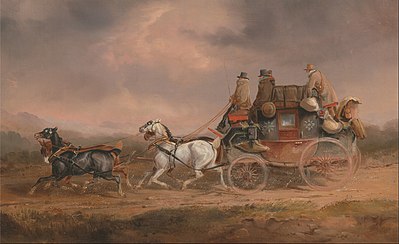
|
The Royal Mail is a postal service and courier company in the United Kingdom, originally established in 1516 when Henry VIII created a "Master of the Posts" position. For most of its history the Royal Mail has been a public service, operating as a government department or a state-owned enterprise. It was privatised in 2013 when a majority of its shares were floated on the London Stock Exchange. The Royal Mail owns and maintains the UK's distinctive red pillar boxes, first introduced in 1852, many of which bear the initials of the monarch. The company's subsidiary, Royal Mail Group Limited, operates the brands Royal Mail and Parcelforce Worldwide, which process letters and parcels respectively. General Logistics Systems, an international logistics company, is a wholly owned subsidiary of the Royal Mail Group. This picture is an oil-on-canvas painting by British artist Charles Cooper Henderson, entitled Mail Coaches on the Road: the Louth–London Royal Mail Progressing at Speed, produced in Chertsey some time between 1820 and 1830. The painting, part of the Paul Mellon Collection, is now located in the Yale Center for British Art in New Haven, Connecticut. Painting credit: Charles Cooper Henderson
Recently featured:
|
June 26

|
|
Glacier Point is a viewpoint above Yosemite Valley in the U.S. state of California. It is located on the south wall of the valley at an elevation of 7,214 feet (2,199 m), 3,200 feet (980 m) above Half Dome Village. The point offers a superb view of several of Yosemite National Park's well-known landmarks. Between 1872 and 1968, it was the site of the Yosemite Firefall. The extreme point of the promontory of Glacier Point is wholly bare, but glacial material is abundant on the slopes below, in the hollow to the west and on the wooded slope above. Its glacial origin is definitely proved by the presence in it of rocks derived from Little Yosemite Valley and the Sierra Nevada. This panoramic view from Glacier Point at sunset was taken in 2013, facing northeast. From left to right, the landforms pictured are Tenaya Canyon, Half Dome, Liberty Cap, Little Yosemite Valley, Vernal Fall and Nevada Fall. Photograph credit: David Iliff
Recently featured:
|
June 27

|
|
The Nobel Prize in Physics is a yearly award given by the Royal Swedish Academy of Sciences for those who have made the most outstanding contributions in the field of physics. It is one of the five Nobel Prizes established by the will of Alfred Nobel in 1895 and awarded since 1901. The first Nobel Prize in Physics was awarded to physicist Wilhelm Röntgen for the discovery of X-rays. The award, administered by the Nobel Foundation, is widely regarded as the most prestigious award that a scientist can receive in physics. It is presented in Stockholm at an annual ceremony on 10 December, the anniversary of Nobel's death. A total of 209 individuals have been awarded the prize. This picture shows the diploma for the Nobel Prize in Physics awarded in December 1903 to Pierre and Marie Curie, as well as Henri Becquerel, whose name is mentioned on the second page of the document. Diploma credit: Sofia Gisberg; restored by Jebulon
Recently featured:
|
June 28

|
Francesca da Rimini and Paolo Malatesta Appraised by Dante and Virgil is a composition painted in at least five very similar versions by Dutch–French Romantic painter Ary Scheffer; all are in oils on canvas. The paintings depict a scene from Dante's Inferno. A pair of lovers, Francesca da Rimini and Paolo Malatesta, are shown in Hell, while Dante and Virgil are on the right viewing them. A stab wound is visible on Malatesta's chest, signifying the pair's murder by his brother, Giovanni, who was da Rimini's husband. This picture is the version of the painting painted in 1855, which hangs in the Louvre in Paris. The original, dating to 1835, is now in the Wallace Collection in London. Others exist in collections in the Hamburger Kunsthalle, the Cleveland Museum of Art in Ohio, and Pittsburgh's Carnegie Museum of Art. Painting credit: Ary Scheffer
Recently featured:
|
June 29

|
The Caribbean reef squid (Sepioteuthis sepioidea) is a species of small, torpedo-shaped squid with undulating fins that extend nearly the entire length of the body, approximately 20 centimetres (8 in) in length. The species is found throughout the Caribbean Sea, as well as off the coast of Florida, commonly in small schools of four to thirty individuals in the shallows associated with reefs. The habitat of the reef squid changes according to its stage of life and size. New hatchlings tend to reside close to the shore, in areas from 0.2 to 1 metre (1 to 3 ft) below the surface, on or under vegetation. This picture shows a Caribbean reef squid in Bari Reef, just off the coast of Bonaire, a Dutch territory in the Caribbean. Photograph credit: Betty Wills |
June 30

|
Panggilan Darah (Indonesian for 'Call of Blood') is a film from the Dutch East Indies (now Indonesia), written and directed by Sutan Usman Karim and produced by Tjho Seng Han for Oriental Film. Released on 30 June 1941, the black-and-white film starred Dhalia and Soerip as orphaned sisters trying to make a living in the colonial capital of Batavia (now Jakarta) as housemaids for a man named Iskak, before moving to Kudus to work at a clove cigarette factory. They later discover that they are Iskak's nieces and are welcomed into his home. The film was shot on location at an orphanage and two factories in Central Java and was a modest commercial success in the Dutch East Indies and Singapore. The acting drew critical praise, while the soundtrack, with nine kroncong songs, was reviewed favourably. Despite this success, Oriental was unable to meet its expenses; the company merged with Multi Film soon afterwards. Panggilan Darah, which was screened as late as 1952, may now be a lost film. This picture shows a 1941 advertisement for the film in the Dutch-language magazine De Orient. Advertisement credit: Oriental Film; retouched by Chris Woodrich |
Picture of the day archives and future dates
